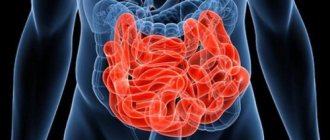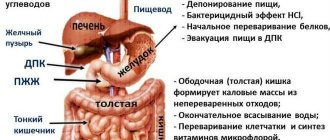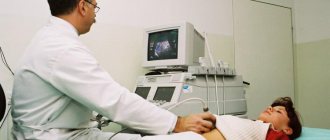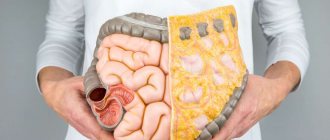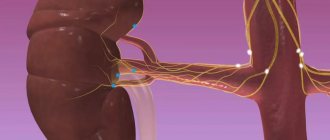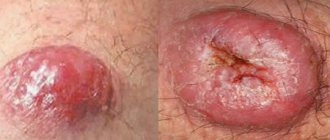Malabsorption in medicine is a malabsorption disorder in the intestine. This condition occurs against the background of inflammation of the organ, gastrointestinal diseases, abdominal trauma, or penetration of a foreign body into the small intestine. As a result of the disorder, nutritional components of food and water are poorly absorbed. Malabsorption is caused by cancer, celiac disease, and granulomatous Crohn's disease. Timely detection and relief of the reasons why the intestines poorly absorb nutrients allows you to prevent serious complications that can delay recovery and require surgery.
Poor absorption in the intestines causes a lack of nutrients from food.
- 5.1 Prevention
Absorption process in the intestine
Absorption or absorption is usually understood as the process of transport of valuable substances supplied with food.
The physiology and structure of the gastrointestinal tract ensures that beneficial components enter the blood plasma, lymph, and tissue fluid, which determines the absorption mechanism. The intestines absorb valuable substances and water through the walls, which contain a large number of microvilli. Processed dietary fiber (chyme) enters the small intestine from the duodenum, where it is further broken down. Next, the lump moves into the ileum. More than 20 intestinal enzymes and intestinal epithelial cells help speed up digestion, but the main function of this section of the gastrointestinal tract is absorption, which occurs with varying intensity in individual zones of the intestine. Carbohydrates enter the bloodstream as glucose, and fats are absorbed into the lymph after being converted into fatty acids and glycerol.
The large intestine has low enzymatic activity, but there is a large number of bacteria that contribute to the breakdown of coarse plant fibers, the formation of vitamin K and individual elements of group B. Mostly water is absorbed in the large intestine. Absorption of carbohydrates is partially possible, which is often used in artificial nutrition by enema.
The large and small intestines more actively absorb particles of chyme and water due to their motility. Peristaltic mechanisms ensure the mixing of food mass with digestive juices and the movement of the pulp through the intestine. Due to the increase in intraintestinal pressure, individual components are absorbed from a specific intestinal cavity into the blood and lymph. Motility is provided by longitudinal and circular muscles, their contractions regulate types of intestinal movements - segmentation and peristalsis.
Reasons for violation
In most cases, the malabsorption mechanism is triggered by concomitant diseases of the gastrointestinal tract, regular consumption of unhealthy food and contaminated water. Cases of impaired absorption have been recorded due to medical intervention in the functioning of the digestive system - drug or surgical treatment. Other, no less significant, provocateurs of the development of the syndrome of difficult absorption in the intestine are:
The causes of malabsorption in the intestine are problems in neighboring organs of the gastrointestinal tract, poor nutrition or the environment.
- infectious diseases, against the background of which the number of pathogenic microbes in the intestinal tract increases, causing enteritis, Whipple's disease or Crohn's disease;
- immune disorders, when the body begins to suppress itself, as well as diseases of the lymphatic system, leading to the spread of pathogens within the gastrointestinal tract (gluten-induced or exudative-hypoproteinemic enteropathy);
- parasitic infestations, for example, tapeworms;
- cardiac and vascular pathologies;
- diabetes;
- intestinal amyloidosis, carcinoid syndrome (caused by the release of hormones by cancerous tumors into the bloodstream).
The influence of enzymes on food digestion processes
Enzymes are involved in the breakdown of complex substances that make up most food products consumed by humans into simple components that can be absorbed and absorbed by the body. Accordingly, pancreatic cells produce:
- proteolytic substances that are involved in the digestion of protein compounds - these include trypsin and chymotrypsin, elastase, carboxypeptidases A and B, ribonucleases;
- substances involved in the digestion of carbohydrate compounds - amylase, lactose, maltose, invertase;
- substances involved in the breakdown of fats - lipase and cholesterase.
All pancreatic enzymes that are involved in the breakdown of protein compounds are secreted by pancreatic cells only in the zymogen state (inactive form). In this case, the cells of the organ itself are reliably protected from self-digestion, and all the activity of these compounds is aimed directly at the digestion of food. When pancreatic juice is released into the lumen of the duodenum, provided that an alkaline reaction is maintained in it, the conversion of inactive trypsinogen into active trypsin begins.
Necessary components of this process are the presence of a sufficient amount of bile, which provides the desired reaction of the environment and eliminates the influence of hydrochloric acid entering the small intestine from the stomach, and the release of enterokinase, which directly triggers the process of trypsinogen transformation. All other transformations occur under the influence of trypsin itself - it triggers the autocatalytic process of activation of the remaining enzymes involved in the digestion of protein compounds.
After their transformation, chymotrypsin, trypsin and elastase begin to destroy peptide bonds in large protein molecules, and carboxypeptidases break down the low molecular weight peptides formed at the first stage into simple amino acids. Some of them are absorbed in this form into the blood through the wall of the small intestine, while other molecules continue to be broken down by the enzymes deoxyribonuclease and ribonuclease.
Types of syndromes
There are 2 main groups of pathologies:
- problems associated with a decrease in the production of pancreatic enzymes into the small intestinal lumen;
- disorders accompanied by a decrease in the level of bile acids in the gastrointestinal tract.
Within each group there are the following clinical signs:
- gastric;
- intestinal;
- hepatic;
- pancreatic.
Malabsorption in the intestine can be congenital or develop throughout life.
There is a classification of malabsorption disorders by type: general and selective (when the absorption of one food component or water is impaired). Malabsorption is classified according to causative factors:
- Congenital (primary), when valuable substances are poorly absorbed against the background of a decrease in enzymatic activity due to the small volume of enzymes. An option with a sufficient amount of enzymes is possible, but they differ in a different chemical structure. This pathology is considered independent.
- Acquired (secondary), when the intestines poorly absorb valuable components after the appearance of problems with the gastrointestinal tract. In this case, the problem is a symptom of a digestive tract disorder.
Secondary malabsorption can take different forms:
- gastrogenic, developed against the background of stomach disease;
- pancreatogenic, caused by inflammation of the pancreas;
- hepatogenic, resulting from liver dysfunction;
- enterogenous - with inflammation of the small intestine, which tries to protect itself from the effects of pathogens;
- endocrine - due to problems with the thyroid gland;
- iatrogenic - an adverse reaction to taking medications such as laxatives, antibacterial agents, cytostatics, or after irradiation;
- postoperative - after surgical intervention in the abdominal cavity.
Features of absorption of various substances
Absorption of carbohydrates
into the blood occurs in the form of monosaccharides.
Glucose
and
galactose
are transported through the apical membrane of the enterocyte
by secondary active transport
-
together with Nα
+ ions located in the intestinal lumen. Glucose and Na + ions on the membrane bind to the GLUT transporter, which transports them into the cell. In a cage
RICE. 13.29. Electronic photograph of microvilli and apical membrane of columnar epithelial cells of the small intestine: A -
low magnification, B - high magnification
the complex is split. Na + ions are transported by active transport thanks to sodium-potassium pumps into the lateral intercellular spaces, and glucose and galactose are transported to the basolateral membrane with the help of GLUT and pass into the interstitial space, and from it into the blood. Fructose
transported by
facilitated diffusion
(GLUT) due to a concentration gradient and is independent of Na + ions (Fig. 13.30).
Protein absorption
occurs in the form of amino acids, dipeptides, tripeptides mainly by secondary active transport through
the apical membrane.
Absorption and transport of amino acids is achieved using transport systems. Five of them operate similar to the glucose transport system and require cotransport of Na + ions. These include carrier proteins of basic, acidic, neutral, beta and gamma amino acids and proline. Two transport systems depend on the presence of Cl- ions.
Dipeptides and tripeptides, thanks to hydrogen ions (H +), are absorbed into enterocytes, in which they are hydrolyzed to amino acids, transported by active carriers into the blood through the basolateral membranes of the cell (Fig. 13.31).
Lipid absorption
after their emulsification with bile salts and hydrolysis of pancreatic lipase occurs in the form of
fatty acids, monoglycerides, cholesterol.
Bile acids , together with fatty acids, monoglycerides, phospholipids and cholesterol, form
micelles
- hydrophilic compounds, in which they are transported to the apical surface of enterocytes, through which fatty acids
diffuse
into the cell.
Bile acids remain in the intestinal lumen and are absorbed into the blood in the ileum, which is carried to the liver. Glycerol
is hydrophilic and does not enter micelles, but enters the cell through diffusion.
In enterocytes,
lipid hydrolysis products
re-esterified triglycerides
, which, together with cholesterol and apoproteins, form
chylomicrons
. Chylomicrons are transported from enterocytes to lymphatic capillaries by
exocytosis
(Fig. 13.32).
Short-chain fatty acids
are transported into the blood.
Characteristic symptoms of the disorder
The clinical picture of impaired absorption in the intestine is bright and pronounced:
Failure of absorption in the intestines provokes diarrhea, weakness, heaviness, flatulence, and weight loss.
- Severe and profuse diarrhea, frequent bowel movements. There is mucus in the stool, and its smell is foul.
- Excessive gas production.
- Constant discomfort, heaviness, even cramps in the abdomen. Symptoms intensify as soon as food enters the gastrointestinal tract.
- Fatigue.
- Visual exhaustion due to sudden weight loss.
- Paleness, “dark circles” under the eyes.
- Anemic signs.
- Night blindness (develops when the intestines do not absorb vitamins well).
- Hypersensitivity of the skin to any damage: instant bruising. This indicates a lack of vitamin K.
- Brittle nails, hair, nagging pain in bones, muscles and joints due to calcium deficiency.
Diagnosis of food absorption in the intestine
If several characteristic symptoms of malabsorption syndrome appear, it is recommended to consult a gastroenterologist. Based on the assessment of complaints, external examination and palpation, the doctor will prescribe a list of necessary tests and instrumental studies.
Today the most popular diagnostic procedures are:
- Laboratory tests: biofluids (blood, urine) - to assess the general condition of the body and determine signs of problems with hematopoiesis;
- feces - to calculate the degree of fat breakdown;
- smear - to identify pathogenic microflora in the intestines;
- exhaled air samples - in order to detect Helicobacter pylori infection, difficulties with digesting lactose, and counting the approximate number of beneficial bacteria in the intestines.
- endoscopy with biopsy of intestinal tissue - a probe technique for visual inspection of the lumen, mucous membranes and walls of the gastrointestinal tract up to the small intestinal section;
What happens to the nutrients?
After entering the blood, beneficial substances and microelements begin to be carried into the cells of the tissues that make up our body. There they take part in metabolism, or metabolism. Metabolic processes are incredibly important for maintaining our vital functions, since it is thanks to them that the necessary proteins, amino acids and other building blocks are formed from which the human body is built. Building materials go a long way from the place where nutrients are absorbed in humans, to every organ, every cell of our body.
A well-coordinated and harmonious metabolism lays a solid foundation for building a healthy body. A person whose metabolism is in order has good health, a lot of energy and a good mood. If this process is disrupted, then problems will not be long in coming. This can lead to disruption of the endocrine system, gout, excess cholesterol, impaired mental development and many other bad things.
Treatment of the syndrome and how to improve absorption
The decision on treatment algorithms is made by a gastroenterologist based on the diagnostic data obtained, the identified causes of the pathology and the degree of severity. Treatment is complex using different techniques. Success largely depends on the correctness of the selected diet. To do this, the doctor recommends those products that do not cause a negative response from the gastrointestinal tract.
The dietary table is constantly adjusted in order to provide the body with all the necessary minerals and vitamins. For example, if lactose is difficult to absorb, dairy products are prohibited. When the intestine does not absorb gluten well, patients refuse foods enriched with gluten protein (products made from wheat or rye flour, oatmeal, barley). For diarrhea, a diet with foods that can retain stool is recommended.
As additional therapy, dietary supplements, vitamin and mineral complexes with iron, calcium, and magnesium are prescribed. Enzyme preparations that stimulate digestive and absorption functions in the large and small intestines help speed up recovery. In inflammatory processes, corticosteroids are required. But the main thing in the treatment of intestinal malabsorption syndrome is considered to be the elimination of the root cause. Infections are fought by taking antibiotics. Doctors resort to surgery in extreme cases - when the patient’s life is at risk or medication measures are ineffective.
Therapy involves taking stimulants of membrane hydrolysis of the small intestine, correctors of metabolic disorders, antidiarrheals (to retain stool), stabilizers of intestinal microflora.
Prevention
There is no universal list of preventive measures to prevent intestinal absorption disorders. When the intestines poorly absorb valuable components, doctors recommend following the general rules of a healthy lifestyle, including proper nutrition with correct thermal and hygienic food processing, exercise, hardening, regular medical examinations, timely treatment of any pathologies, in particular in the gastrointestinal tract, prevention of parasitic infestation , dietary adjustments to eliminate prolonged diarrhea and constipation (lasting from 3 days).
Intestinal pollution
The intestine is the place where the absorption of nutrients by the villi occurs. When its walls become contaminated with food debris, stones or parasites, access to these formations is blocked. Because of this, the absorption capacity of some parts of the intestine is reduced, and sometimes, with a completely unhealthy lifestyle, almost the entire intestinal tract becomes clogged. It is this phenomenon that has led to the fact that modern people need so much food. After all, if the intestines are almost not involved in digestion, then most of the nutrients will not be absorbed. The body will have to be content with what it manages to get in the mouth and stomach. Accordingly, you have to consume inadequate amounts of food in order to get your daily requirement of nutrients.
To keep the place where nutrients enter the blood clean, you need to eat healthy foods and not eat incompatible foods at one time. For example, you should not combine protein foods with carbohydrates; it is better to eat dairy products separately from everything else, like fruits. It would also be a good idea to introduce more vegetables into your diet. The fibers from which they are composed will pass through the intestines, removing impurities that have accumulated on its walls.
